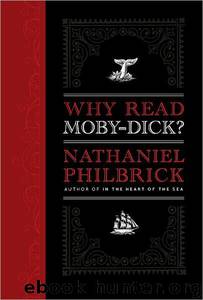Why Read Moby-Dick?

Author:Nathaniel Philbrick
Language: eng
Format: mobi
Tags: Non-fiction
ISBN: 9781101545218
Publisher: Viking Adult
Published: 2011-10-01T00:00:00+00:00
14
Unflinching Reality
Within weeks of meeting Melville in August 1850, Hawthorne had procured copies of the young novelist’s two latest books, Redburn and White-Jacket. Both were based on Melville’s own experiences at sea: Redburn recounts his first voyage as a common seaman from New York City to Liverpool and back; White-Jacket tells of his stint aboard the naval frigate that took him from Hawaii to Boston. Hawthorne read the novels, his wife, Sophia, recounted to Evert Duyckinck, “on the new hay in the barn—which is a delightful place for the perusal of worthy books.” In a letter of his own to Duyckinck, Hawthorne spoke of his “progressive appreciation” of Melville’s work. “No writer ever put the reality before his reader more unflinchingly,” he wrote.
Melville’s great strength (a strength that sometimes got lost in his Ahab-like preoccupation with what he once called “ontological heroics”) was an almost journalistic ability to record the reality of being alive at a particular moment. In Moby-Dick we feel in a profoundly emotional and visceral way what it was like to be a whaleman in the nineteenth century. In the chapter titled “The Affidavit,” Melville makes it clear that what he is describing could really have happened. The reality of whaling is, he insists, more incredible than anything a novelist could invent. “So ignorant are most landsmen of some of the plainest and most palpable wonders of the world,” he writes, “that without some hints touching the plain facts, historical and otherwise, of the fishery, they might scout at Moby Dick as a monstrous fable, or still worse and more detestable, a hideous and intolerable allegory.”
Ishmael points to several historical instances, including the story of the Essex, that illustrate “the great power and malice at times of the sperm whale.” Clearly, a whale is no ship’s carpenter. Far from passive and dull, a bull whale not only is huge but also thinks with the crafty intelligence of a man.
Ishmael describes the wondrous way a craft as tiny as a whaleboat negotiates the massive swells of the ocean: “[T]he sudden profound dip into the watery glens and hollows; the keen spurrings and goadings to gain the top of the opposite hill; the headlong, sled-like slide down its other side;—all these, with the cries of the headsmen and harpooneers, and the shuddering gasps of the oarsmen . . . all this was thrilling.” And then there is the even more wondrous way a whale dives underneath the sea: “[T]he monster perpendicularly flitted his tail forty feet into the air, and then sank out of sight like a tower swallowed up.”
No one has ever written a more beautiful and horrifying account of the death of a whale than the magnificent set piece contained in chapter 61, “Stubb Kills a Whale.” Perched on the onrushing bow of the whaleboat, the second mate merrily probes for “the life” of the whale with his lance until the giant creature begins to die. “His tormented body rolled not in brine but in blood, which bubbled and seethed for furlongs behind in their wake.
Download
This site does not store any files on its server. We only index and link to content provided by other sites. Please contact the content providers to delete copyright contents if any and email us, we'll remove relevant links or contents immediately.
| African | Asian |
| Australian & Oceanian | Canadian |
| Caribbean & Latin American | European |
| Jewish | Middle Eastern |
| Russian | United States |
4 3 2 1: A Novel by Paul Auster(12334)
The handmaid's tale by Margaret Atwood(7712)
Giovanni's Room by James Baldwin(7261)
Asking the Right Questions: A Guide to Critical Thinking by M. Neil Browne & Stuart M. Keeley(5712)
Big Magic: Creative Living Beyond Fear by Elizabeth Gilbert(5682)
Ego Is the Enemy by Ryan Holiday(5352)
The Body: A Guide for Occupants by Bill Bryson(5035)
On Writing A Memoir of the Craft by Stephen King(4893)
Ken Follett - World without end by Ken Follett(4688)
Adulting by Kelly Williams Brown(4536)
Bluets by Maggie Nelson(4515)
Eat That Frog! by Brian Tracy(4484)
Guilty Pleasures by Laurell K Hamilton(4395)
The Poetry of Pablo Neruda by Pablo Neruda(4068)
Alive: The Story of the Andes Survivors by Piers Paul Read(4001)
White Noise - A Novel by Don DeLillo(3982)
Fingerprints of the Gods by Graham Hancock(3966)
The Book of Joy by Dalai Lama(3947)
The Bookshop by Penelope Fitzgerald(3812)
